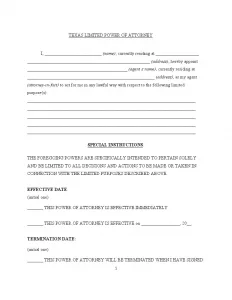Texas Limited Power of Attorney Form
As stated in Chapter 751, Title 2 of the Estates Code, a Texas limited power of attorney conducts the interests of the declarant who wishes to delegate certain authorities to another adult individual ( an agent or an attorney-in-fact). Proceeding from the type of record, the form restricts the powers to business-related matters, including transactions, and is not durable. The POA template contains paragraphs devoted to the determination of the effective period.
See all the Texas power of attorney forms you can fill out by following this link to our Texas article.

Build Your Document
Answer a few simple questions to make your document in minutes
Save and Print
Save progress and finish on any device, download and print anytime
Sign and Use
Your valid, lawyer-approved document is ready
To avoid ambiguity and unfavorable situations, the principal should conclude a Texas limited POA regarding the following terms:
- A principal and the agent must be of sound mind and at least 18 years old.
- Texas limited POA requires compulsory notarization.
- As the limited document contains a record of effective time frames, the POA will be revoked on the termination date by default.
- If the designated attorney-in-fact fails or refuses to conduct the delegated powers, the principal should appoint a successor agent for backup.
To reduce analog situations, one should be prudent while engaging an agent. Remember, this person will become your representative in your absence due to personal or business reasons.
Texas Limited Power of Attorney Form Details
| Document Name | Texas Limited Power of Attorney Form |
| Other Name | Texas Special Power of Attorney |
| Relevant Laws | Texas Statutes, Estates Code, Title 2, Chapter 751 |
| Avg. Time to Fill Out | 8 minutes |
| # of Fillable Fields | 32 |
| Available Formats | Adobe PDF |
Filling Out Texas Limited POA
If you decide to transfer certain authorities to an appointed person, you need to complete a Texas Limited Power of Attorney template to provide written proof of your preferences. Make use of our latest form-building software to generate corresponding paperwork online. You are welcome to fill out the template instantly.
1. Determine the Declarant’s Identity
The first thing you should do while completing the template is to write the principal’s legal name and contact data. Submit the full residency, including street, city, and state, and provide a phone number for emergency cases.

2. Determine the Agent’s Identity
The next step involves identifying the designated representative who will act on the principal’s behalf and in his or her best interests.
Enter the agent’s legal name, address, and contact phone number.

3. Specify the Granted Authority
Describe the powers that you wish to assign to your attorney-in-fact and list them on the spare lines. If there are specific things you don’t allow your agent to conduct, make sure to write them down. Be as detailed as possible to avoid confusing moments in the future.

4. Specify the Duration of the Limited POA
Every document possesses an effective time frame. This section requires the principal to determine the effective date and the moment of termination.
Decide on the preferred alternatives and place your initials next to the acceptable variant. Pick one for the “Effective Date” section and one in the “Termination Date” section.
Enter the current date in a day-month-year format to complete this part.

5. Define a Successor Agent
If you feel that a backup is a good idea, please introduce a successor attorney-in-fact. Life is unpredictable and can create unforeseen circumstances when an initially appointed person cannot execute the delegated authority.
If you decide to provide a backup agent, you are likely to protect yourself if any misunderstanding arises.
Enter the successor’s legal name and residence, including the street, city, and state. Enter his or her contact phone number, as it will be needed to notify the person about the appointment.

6. Provide the Principal’s Signature
The declarant must sign the Texas limited POA template in the presence of a notary to make the document complete.
Place your signature on the corresponding line and specify the date of completion.

7. Acquire Notarization
Once all required data is filled out, and the principal has provided their signature and the identification documents, a notary public can close the form and affix their signature and state seal.

